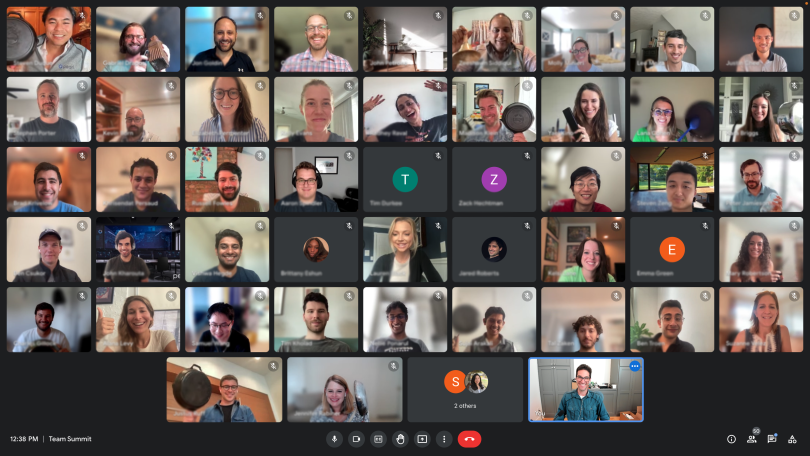Matthew Hogains relishes being a morning person.
It allows ample time to kick-start his day with routine activities like brewing the perfect cup of coffee or spending time in the fresh air with his dogs. In addition, as a software engineer at Narmi, a regular morning routine lets Hogains design a repetitious environment to tap into a flow state — tuning out the rest of the world and smoothly diving into any pending task at hand without distraction.
“It starts with one thing, then the next, and then you realize it’s 2 p.m. and you’ve knocked off a good chunk of what you needed today,” he said. “Not every day is perfect, but sticking to my routine is key for getting into a good flow.”
But what exactly is a flow state? Flow states occur across a vast spectrum of activities and interests ranging from athletic training to coding, when the mind can enter a subconscious state of autonomous focus.
Originally coined by happiness researcher Mihaly Csikszentmihalyi in his 1990 book Flow: The Psychology of Optimal Experience, many test participants he interviewed during his studies described their optimal states of performance as “instances when their work simply flowed out of them without much effort.”
For software engineers like Hogains and Pearl Health’s Kelsi Lane, entering a flow state has proven to be an ample method for tackling intense coding projects by establishing a natural rhythm, allowing their fingers to get into the zone as they pummel their keyboards with finesse.
“Are you listening to noise or is it silent? Are you in a room alone or outside with things around you?” Lane inquired. “Then next time you want to tap into that flow state, try to replicate that same environment you had previously.”
To learn more about the art of flow states and their various benefits, Built In NYC sat down with Hogains and Lane to discuss their individual approaches and the biggest pieces of advice for any engineer looking to one-up their productivity levels.

Narmi is a financial tech company that operates with the goal of transforming community banks and credit unions.
Describe what your flow state looks like.
You often hear about the people being morning people or night people — I happen to be a morning person. The moment the sun peeks through the curtains is when my flow state begins. Once all the normal routine activities are done — letting the dogs out for a run, showering, making the bed — I grab a 32-ounce water bottle and a piping hot coffee, turn on NPR and plop myself down at my home office.
I also have a separate commuting routine to accommodate my hybrid work schedule. It starts out similarly, but includes a 40-minute commute into the city while re-reading my currently selected book, Harry Potter.
It’s all about consistency, repetition and rhythm. I work swiftly and with purpose from 7 a.m. to around 2 p.m. This is because my mind is fond of the idea of a new day. I spend much of the previous evening thinking about what’s to come either tomorrow or in the next few months. Once that day comes, I must accomplish something on my never-ending list of to-dos. The point is to always accomplish something.
How do you personally get into a flow state?
My flow state begins with my morning routine, even on the days it’s fragmented. Once I’ve had my fill of water and work-unrelated information, I check Slack and clear out all my unread messages. Then it’s off to email land — which, luckily, is sparse for software engineers. After email, I go to GitHub to check my priorities and things I need to update or pick up for the day.
That’s usually the point when my coffee has cooled down to an acceptable level, and with one good gulp, I dig in. I pick a task that I want to focus on for the morning which usually gives me about an hour to work through a problem that was bothering me the night before or tackle a new issue that’s been languishing on my Kanban board.
The morning routine ends, the day begins and my flow is in full swing. Making sure I start my day with dogs, water, shower and making the bed gets my brain flowing in a way that helps ensure I have a smooth and productive day.
It’s all about consistency, repetition and rhythm — I work swiftly and with purpose from 7 a.m. to around 2 p.m.”
What tips or advice do you have for others who might be struggling to get in the zone?
For non-morning people or people without daily repetition, find a routine or make one up. Try different things. The routine before work — whether lively for us morning people or gloomy for night people — is something that gets you up and going. If you were on another schedule or telecommuting to London from California, your specific circumstance informs your routine. Do anything.
Yoga, jogging, journaling — it can be any activity. It is a gratifying feeling knowing you did the things you needed to do.

Pearl Health is democratizing access to value in healthcare, providing physicians with the tools to provide great care.
Describe what your flow state looks like.
To me, flow state is when I’m able to give my full attention to an activity. Whether it’s focusing on a certain problem at work or trying to tackle a new section of a trail on my bike, being able to zone in on what I’m doing and get rid of distractions helps me to complete the task I’m trying to perform.
How do you personally get into a flow state?
I recently started using focus mode on my phone to limit notifications while I work: This helps me not get distracted every time I get a notification. If the room is too quiet, it’s distracting for me, so I always listen to music or a podcast while I work. One investment I made when I worked in an office was a nice set of noise-canceling headphones. I still will use these occasionally at home if I really need to focus on something.
In the mornings, I also need to make sure I have some coffee, or my brain doesn’t work very well.
The next time you find yourself in that ‘flow,’ pay attention to your environment.”
What tips or advice do you have for others who might be struggling to get in the zone?
What works for someone else may not work for you, so the next time you find yourself in that “flow,” pay attention to your environment. You can slowly introduce new things like music, white noise and other factors, or change up things little by little until you find what ultimately works best for you.









